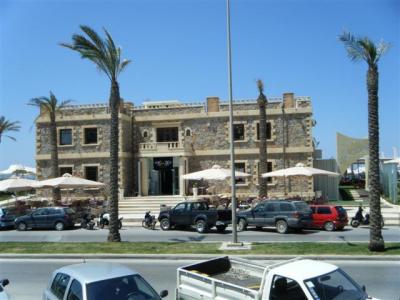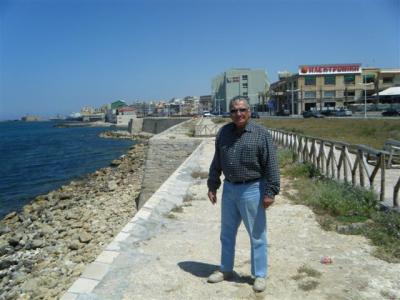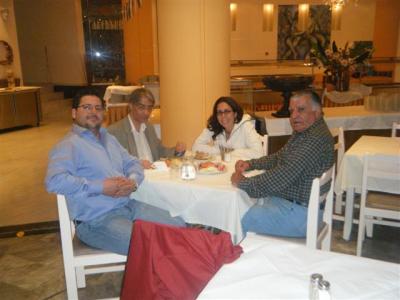Saturday May 16 – Today Eric, Christi, John, and a family friend named Marga went to Irakleon, the biggest city in Crete, to do some sightseeing. Because of its nice natural harbor, Irakleon has been a major hub dating back to the most ancient times. The Minoan ruins of Knossos are just outside Irakleon. But, because of war and other devastations throughout recent history, there are few old buildings or ruins still left in Irakleon today.
We went downtown and walked along the waterfront for a while. Irakleon’s waterfront is attractive, with mostly modern, aesthetically appealing buildings. It looks like the walls from the Venetian era have been recreated, which helps give the city some of the charm and character that Rythmeno and Chania have. There are a couple old style buildings, as well, which further adds charm.


After our walk, we drove around the city some more. The outer areas of Irakleon are similar to the other bigger cities on Crete. Eric and Christi have been wanting to go to the aquarium the last few times we were here, but never made it. When we were tired of driving around town, instead of going back to Costas’, we more or less kidnapped John and Marga and made them go to the aquarium with us.
We all enjoyed the aquarium. It was bigger and more modern than we had expected. For the most part, the aquarium featured species found in the local waters, and there was quite an interesting range of species were on display. Some of the tanks were enormous. Eric and Christi enjoyed seeing creatures that are hard to see in the while, like scorpionfish and lobster. We also like watching the turtles, rays and jellyfish just because they are so graceful. John liked seeing the large creatures, like the giants jacks, groupers, eels, and especially the sharks. We all got a kick out of watching the octopus walk around, suctioning itself to the glass with each step. As we mentioned in our post about diving in Crete, due to the lack of coral reefs, there just isn’t very much color in the water. Most species tend to be a silvery or blue-gray color to blend with the environment.
There were a few small tanks that featured tropical species, including sea horses, starfish, colorful wrasse, trigger fish, anemones and soft corals. However, they didn’t seem to have the sophisticated technology needed to make the kinds of displays we saw in places like Monaco and Atlanta.
The whole aquarium was interesting, but we found the last display to be absolutely fascinating. It was a movie, and we figured the movie would be about the things we had just learned about here in the aquarium. We were quite surprised when we realized it was a movie about life in the deep parts of the ocean that get no sunlight. Christi enjoyed it so much that she would have sat through it a second time if the rest of the group would have let her. Up until recently, it was believed that without the sun’s energy there could be no life. Advanced submarines were created that can withstand pressures of the extreme and dark depths. Their purpose was to study the ocean floor, and volcanoes located within the ocean floor. It wasn’t expected they would find life forms in water this deep, and it turns out there are a surprising number of highly adapted life forms down there.
Some of the life forms live around these underwater volcanoes, and get their energy from the heat emitted by the volcano. Some forms of life include crabs, scaleworms, anemones, snails, mussels, barnacles, shrimp, crab, lobster, polyp corals and more. Every species has evolved to survive at that depth. For example, the polyp corals are enormously large compared to a regular polyp coral. The large size makes it easier for them to grab food. There are also microbes, tube worms and bacteria that live symbiotically. Interestingly enough, some of these tube worms and bacteria live in water so hot that, up until their discovery, it was believed that nothing could live at that hot of a temperature.
Just as shocking was the discovery of species that live far away from the volcanoes, where there is no apparent source of energy at all to sustain life. There are several predator species that survive off of carcasses that sink into the deep water. When a carcass manages to fall into their range, the assorted species go on a feeding frenzy. When they are done, the bones are picked so perfectly clean, and are so perfectly intact in the shape of the animal that it looks the bones are on display in a museum. It is weird.
On the way back to Costas’ we talked about how much Crete has grown in recent years. It seems to be tremendously more developed than it was in 2002. Even in the last 9 months, there has been a glut of new buildings that have gone up.
More people arrived for the wedding tomorrow, including Andronikos. We again spent the evening socializing with family and friends. Here is a family photo:

